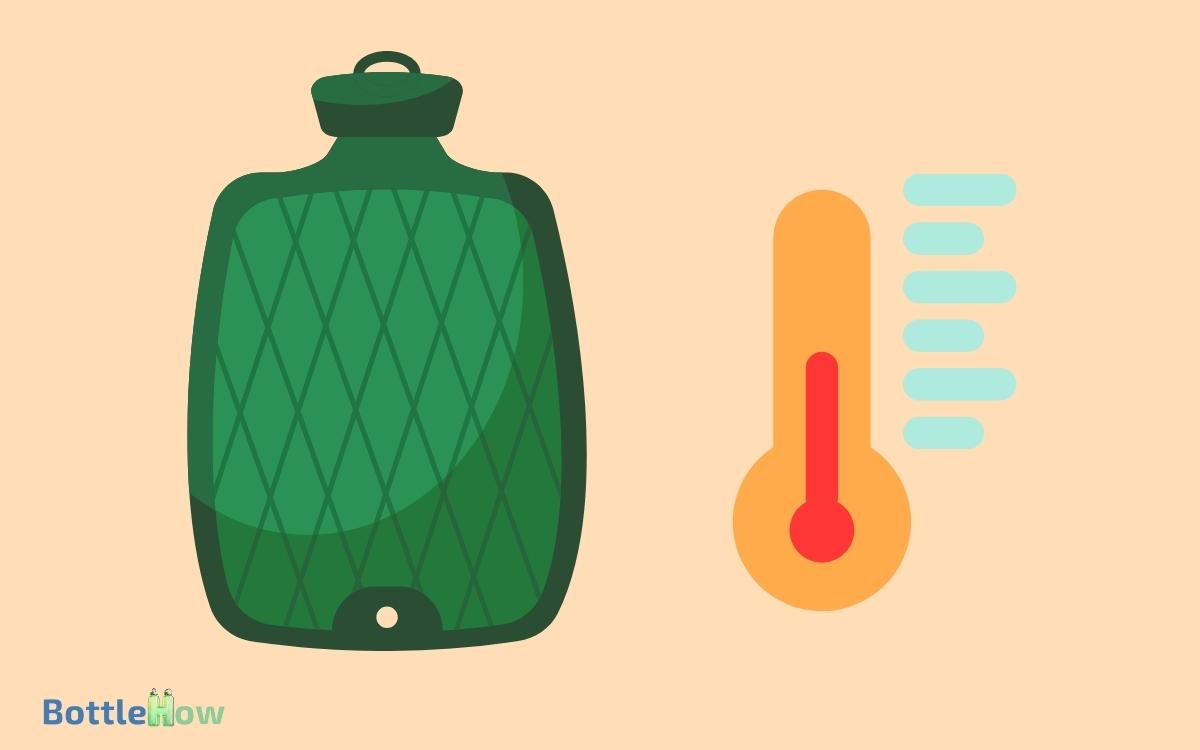Hot Water Bottle to Keep Warm: A Complete Guide!
A hot water bottle is an economical, portable method to stay warm. Choose one based on material and capacity.
Fill it two-thirds full with hot—not boiling—water, expel excess air, and securely fasten the stopper.
Always check for leaks and wear. Use it to warm your bed or during outdoor activities. For safety, avoid direct skin contact; use a cover. Inspect and store properly to maximize its longevity.
Besides warmth, it’s excellent for muscle aches and improving circulation. Stay tuned to learn more about creative uses and additional benefits.

Key Takeaways
Benefits of Hot Water Bottles
When you use a hot water bottle, you effectively harness a portable and economical heat source to maintain body warmth.
The device’s primary benefit is its ability to provide localized heat therapy, which can alleviate muscle aches and improve blood circulation.
By filling the bottle with hot water, you create a sustained heat source that gradually releases thermal energy. This method is both energy-efficient and safe when used correctly. The steady warmth helps to soothe discomfort and can be used for various therapeutic purposes. For instance, a hot water bottle for ear wax buildup may aid in softening the wax, making it easier to remove naturally. However, it is important to ensure the temperature is safe to avoid burns or discomfort.
In addition, hot water bottles are versatile—they can be used in bed, at your workstation, or while lounging.
Their simplicity means they don’t require electricity, making them a reliable option during power outages.
Moreover, their compact design ensures they’re easy to store and transport, enhancing their practicality.
Choosing the Right Hot Water Bottle
Selecting the right hot water bottle involves considering factors such as material composition, capacity, safety features, and intended use. Opt for bottles made from high-quality rubber or thermoplastic for durability and flexibility.
Assess the capacity, typically ranging from 500ml to 2 liters, to suit your heating needs. Prioritize safety features like a secure screw cap to prevent leaks and burns. Some models come with built-in insulation covers for additional protection and heat retention.
Evaluate the intended use: for localized pain relief, a smaller bottle may suffice, whereas for warming larger areas, a bigger one is ideal. Verify that the chosen product meets safety standards and certifications.
How to Fill Your Hot Water Bottle
After selecting a suitable hot water bottle, it’s crucial to know the proper method for filling it to guarantee maximum safety and efficiency.
First, confirm the bottle is empty and check for any damage. Boil water and let it cool for a minute to avoid scalding.
Using a funnel, pour water into the bottle until it’s two-thirds full. This prevents overexpansion. Carefully expel any air by gently pressing on the bottle until water appears at the opening.
Securely screw the stopper and check for leaks by turning the bottle upside down. Remember, don’t use boiling water directly as it may degrade the rubber.
Following these steps ensures your hot water bottle functions effectively and lasts longer.
Safety Tips for Use
To guarantee safe usage of your hot water bottle, always inspect the stopper and rubber for any signs of wear or damage before each use. This prevents leaks and potential burns.
Only fill the bottle up to two-thirds full with hot, but not boiling, water to avoid excessive pressure. Securely replace the stopper to make certain no water escapes.
Here are three essential tips:
- Temperature Caution: Avoid using boiling water to prevent degradation of the rubber and possible scalding.
- Regular Inspection: Replace your hot water bottle every two years to minimize the risk of rupture.
- Storage Protocol: Store your hot water bottle empty and with the stopper removed, in a cool, dry place to extend its lifespan.
Creative Uses for Warmth
Harnessing the warmth of your hot water bottle, you can creatively use it to heat your bed before sleep or as a comforting source of heat during outdoor activities in cold weather.
To efficiently warm your bed, place the hot water bottle under the covers for 15 minutes before bedtime.
For outdoor warmth, position the bottle inside your jacket or sleeping bag. Guarantee a secure fit to prevent burns.
| Activity | Usage Technique |
|---|---|
| Bed Warming | Place under covers 15 mins before sleep |
| Outdoor Activities | Keep inside jacket or sleeping bag |
| Car Travel | Position on lap or behind back for warmth |
Relieving Aches and Pains
You can use a hot water bottle to effectively alleviate muscle cramps by applying it directly to the affected area. This helps promote blood flow and reduce tension.
For easing joint pain, place the hot water bottle on the joint for 15-20 minutes. This can enhance circulation and decrease stiffness. Always guarantee the water temperature is safe to prevent burns or skin irritation.
Soothing Muscle Cramps
Applying a hot water bottle to the affected area can effectively alleviate muscle cramps by promoting blood flow and relaxing tight muscle fibers.
To maximize relief, follow these steps:
- Preparation: Fill the hot water bottle with water heated to approximately 104°F (40°C). Make sure the bottle is securely sealed to prevent leaks.
- Application: Place the hot water bottle on the cramp-affected muscle, using a cloth barrier to avoid direct skin contact and potential burns.
- Duration: Maintain the application for 15-20 minutes, checking periodically to ensure comfort and prevent overheating.
This method enhances vasodilation, improving oxygen and nutrient delivery to the muscles, which helps in reducing cramps. Remember, proper technique and safety precautions are key for effective muscle cramp relief.
Easing Joint Pain
Just as hot water bottles can alleviate muscle cramps, they can also provide significant relief for joint pain by promoting circulation and reducing inflammation in the affected area.
To use a hot water bottle for joint pain, fill it with hot, but not boiling, water—ideally around 104-113°F (40-45°C). Make sure the bottle is securely sealed to prevent leaks.
Apply the bottle to the affected joint, using a cloth barrier to protect your skin from direct heat exposure.
Maintain the application for 15-20 minutes, allowing the heat to penetrate the tissues, increase blood flow, and relax tight muscles.
This method can be especially effective for conditions like arthritis, bursitis, and tendonitis, offering a non-invasive, drug-free solution to manage pain and stiffness.
Eco-Friendly Heating Options
You can greatly reduce your carbon footprint by choosing sustainable heating solutions like hot water bottles.
These devices require minimal energy and leverage renewable resources, offering an eco-friendly alternative to electric heaters.
Sustainable Heating Solutions
Harnessing geothermal energy through ground-source heat pumps offers an efficient and eco-friendly way to maintain indoor warmth.
By tapping into the earth’s constant underground temperature, you can achieve substantial energy savings.
Here’s how:
- Install Ground Loops: Bury pipes in the ground to circulate a water-based solution, absorbing geothermal heat.
- Heat Exchange Process: Utilize the heat pump to transfer this absorbed heat into your home’s heating system.
- Distribution: Disperse the heat through underfloor heating or radiators for consistent indoor warmth.
This method reduces reliance on fossil fuels, lowers greenhouse gas emissions, and can cut your heating bills significantly.
By investing in a ground-source heat pump system, you’re making a long-term commitment to both sustainability and cost efficiency.
Reduce Carbon Footprint
Reducing your carbon footprint through eco-friendly heating options can be achieved by integrating renewable energy sources into your home’s heating system.
Consider installing a geothermal heat pump that utilizes the Earth’s stable underground temperatures for efficient heating.
Solar thermal systems are another option; they harness solar radiation to heat water, reducing reliance on fossil fuels.
You might also explore biomass boilers, which burn organic materials like wood pellets, providing a sustainable heat source.
Insulating your home effectively will maximize these systems’ efficiency, decreasing overall energy consumption.
Smart thermostats offer precise control over heating cycles, further optimizing energy use.
Caring for Your Hot Water Bottle
Proper care for your hot water bottle guarantees its longevity and safe usage. To maintain its condition, always follow these steps:
- Empty after Use: Completely empty the bottle after each use. Leaving water inside can lead to material degradation and bacterial growth.
- Store Appropriately: Store the bottle in a cool, dry place, away from direct sunlight and heat sources. Excessive heat exposure can cause the rubber to deteriorate.
- Inspect Regularly: Regularly inspect for any signs of wear, such as cracks or thinning. If you notice any damage, replace the bottle immediately to avoid potential burns or leaks.
Conclusion
Coincidentally, you’ve explored how a hot water bottle isn’t just for warmth; it’s an eco-friendly, versatile solution for aches and pains.
By choosing the right bottle, mastering the filling technique, and following safety protocols, you maximize its benefits. Remember to creatively utilize it for comfort and maintain it properly for longevity.
Implementing these detailed instructions guarantees you get the most out of this simple yet effective heating option.
So, isn’t it time to embrace the warmth and relief it offers?






